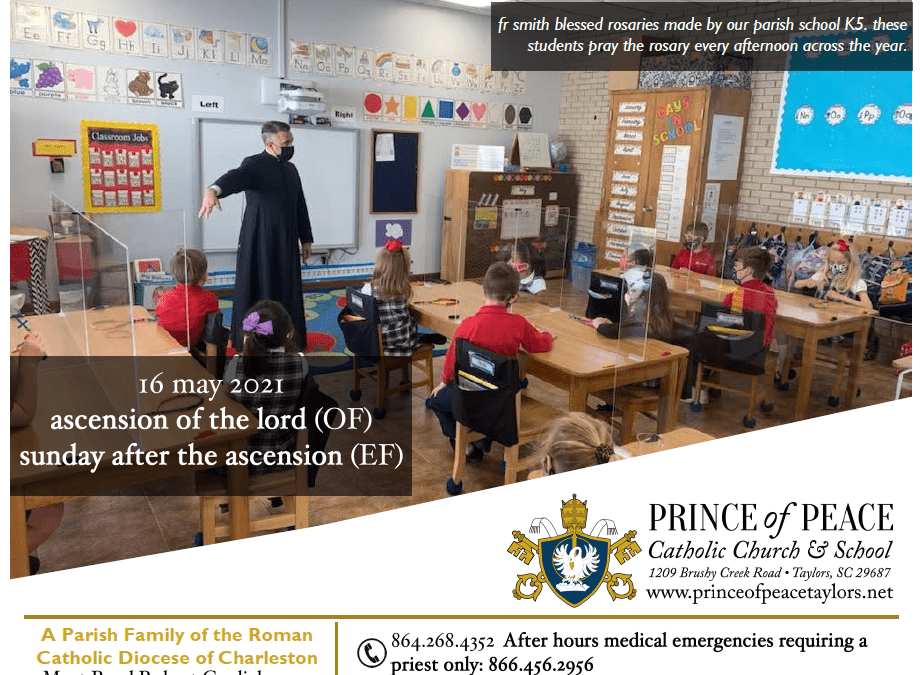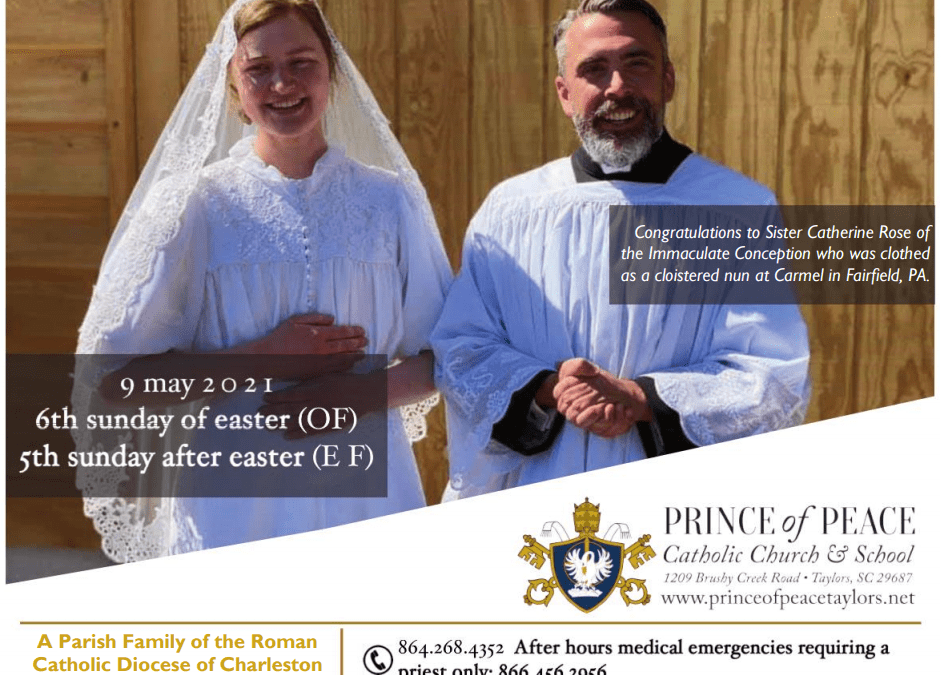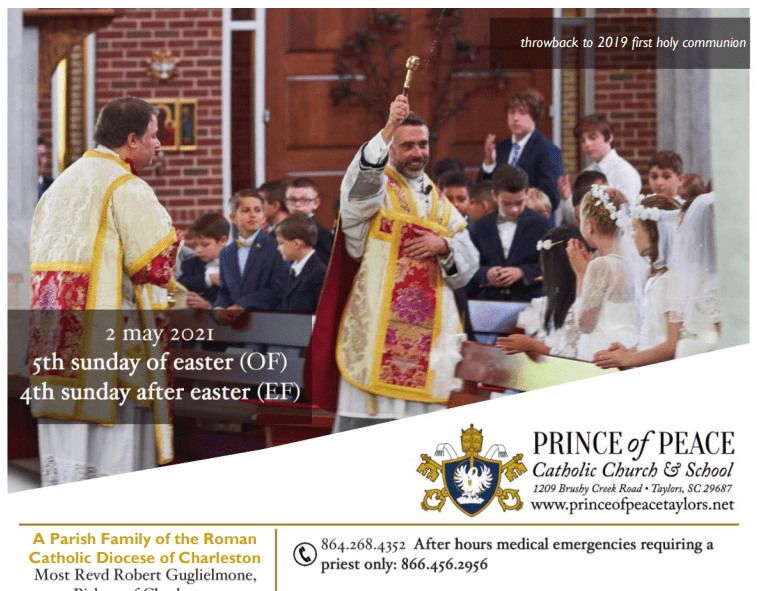
16 May 2021 Bulletin
Click to read the 16 May 2021 Bulletin

Click to read the 16 May 2021 Bulletin

waitlist only FREE Academic STEAM Robotics Summer Camp: The academic program is driven from Catapult Learning’s Summer Journey Program that combines Achieve Literacy and Mathematics, as well as curricula from Prince of Peace. The enrichment programing is STEM Robotics driven from the Engineering Design Process. Ultimately, the experience would balance academic enrichment and learning with fun and engaging activities.
nearly full Totus Tuus Vacation Bible School: 11-16 July 2021. 9a-2.30p on Monday-Friday for students entering grades 1-6, 7p-9p on Sunday-Thursday for students entering grades 7-12. Each grade (1-6) will be limited to 12 students. Cost is $35/child, $80 maximum/family. What makes Totus Tuus special? The Totus Tuus program was developed by Catholics and teaches the Catholic faith. Totus Tuus is run by a team of enthusiastic, college-age adults who are on fire for our faith. The Totus Tuus program follows a 6-year curriculum cycle. So even if you came last year, or three years ago, the material is going to be different. Not to mention, the team changes each year so the leaders will have a totally fresh perspective. The elementary program sells out every year, so register early. For registration & additional information, contact Maria Barontini at maria.barontini@princeofpeacetaylors.org.
1 spot left Archery Camp will be 21-25 June from 9a-11.30a each day for rising 4th grade-9th grade students of the school or parish. Learn the basics of the National Archery in Schools Program sponsored by the South Carolina Department of Natural Resources. The cost is $85 for the 1st child. And, in families with multiple children, $75 for the 2nd child, and $65 for 3rd child+. Limit 12 in the camp (first come, first served paid & completed registration). Until further notice by the Diocese of Charleston, COVID protocols will be followed. Email Coach Moreauor pick up the forms in the school office. Deadline 28 May.
Dribble for Destiny Summer Basketball Camp is for ages 8-13 boys and girls. It will be held 9a-12p on Tuesday, 6 July—Friday, 9 July. Camp includes ball dribbling, passing, shooting, ball handling, daily contests, daily devotions, video, snack and full court play round out each days activities. The Awards Ceremony is on 9 July @ 11a. The cost is $119 and includes a t-shirt OR ball. Registration forms are available in the parish office or online. Maximum of 50 athletes.
Summer Art Camp with Marilyn Alber is a great way for kids entering 1st-8th grade to kick off summer and be creative. Choose between week 1 (14-18 June) and/or week 2 (21-25 June). Classes are held for 2 hours each day Monday-Friday in the Media & Art Bldg. The cost of a 1-week session is $160, materials provided. The registration deadline is Friday, 28 May. No refunds are given after 1 June. Forms are available at the school office. For additional information, please contact Marilyn at mmalber@att.net.
Come play “pick up” soccer this summer at POPCS. Mr. Barontini will be supervising a series of small-sided soccer games, Thursday nights from June 17 to July 15 (with a rain makeup game on July 22). We will be playing a series of 3 v 3 or 4 v 4 games to have fun, keep in contact with friends or make new ones. Contact nathan.barontini@

10 May: Feast of Saint Damien of Molokai. Joseph de Veuser, who took the religious name Damien, was born into a large Belgian farming family in 1840. During his youth he felt called to become a Catholic missionary. He joined the Congregation of the Sacred Hearts of Jesus and Mary. His superiors planned to send Damien’s brother, a member of the same congregation, to Hawaii. But he became sick, and Damien arranged to take his place. Brother Damien arrived in Honolulu in 1864 and was ordained a priest the same year. Nine years later, Father Damien responded to his bishop’s call for priests to serve on the leper colony of Molokai. The island was a wasteland, where quarantined lepers faced hopeless conditions and extreme deprivation. Father Damien volunteered to go. Upon arrival, he found the colony in disarray. Anarchy reigned; patients were not cared for; every kind of immorality was on display. There was no law or order. Fr. Damien provided leadership. Where other missionaries had kept lepers at arms’ length, Fr. Damien instead immersed himself in their life and showed God’s love. He had them come together to build houses, schools and eventually the parish church, St. Philomena. The church still stands today. The sick were cared for and the dead buried. Order and routine made the colony livable. Fr. Damien personally provided much of the care the people needed. Fr. Damien’s work helped to raise the lepers up from their physical sufferings, while also making them aware of their worth as beloved children of God. Although he could not take away suffering, he could change its meaning as a redemptive path toward eternal life. Fr. Damien was supposed to be replaced by another volunteer. However, he grew attached to the people and his work. He asked permission to permanently stay at the colony to serve. His request was granted. Fr. Damien drew strength from Eucharistic adoration and the celebration of the Mass, but longed for another priest so that he could receive the sacrament of confession. In December 1884, Fr. Damien lost all feeling in his feet. It was an early, but unmistakable sign that he had contracted leprosy. He continued his work, despite the illness slowing taking over his body. He often spent time in the presence of the Eucharist: “It is at the foot of the altar that we find the strength we need in our isolation,” he wrote. The disease eventually robbed him of his eyesight, speech and mobility. In the end, priests of his congregation arrived to administer last sacraments to the dying priest. Father Damien died during Holy Week, on April 15, 1889, after spending sixteen years working on the colony. He was beatified in 1995 and canonized in 2009. He is the patron saint of people with leprosy.
(His feast day is an unusual date selection. It is customary for a saint’s feast to be the date that he enters into eternal life. However, April 15 often falls during Lent when the church does not celebrate optional memorials. Thus, May 10 was picked: it marks the day on which Damien performed a particular act of supreme charity and selflessness that would ultimately lead to his canonization. May 10 was the date in 1873 that he first stepped onto the island of Molokai.)
Ideas for celebrating this feast at home:
(sources: Catholicnewsagency.com, CatholicCulture.org, Hawaiiancatholicherald.com)

Click to read the 9 May 2021 Bulletin

3 May: Feast of Saints Philip and James, Apostles. For centuries, the Church had feasts to honor only four apostles: Sts. Peter and Paul, St. John, St. Andrew. The Church memorialized the remaining apostles on June 29. Then, in the sixth century, the bodies of Sts. Philip and James were brought together to Rome and laid to rest in the Basilica of the Holy Apostles. Because of this, the Church instituted a shared feast day for these two apostles.
St. James the Less, a brother of the Apostle Jude, was of Cana of Galilee. He was referred to as “the Less” to distinguish him from the other apostle James (the brother of John). This nickname likely refers to his younger age, not that he was any less important. This James was called “the brother of the Lord,” because his mother was related to the Blessed Virgin Mary. Jesus appeared to James before any other apostle after the resurrection (1 Cor 15:7). James is the author of the Epistle of St. James. He became bishop of the Church in Jerusalem and played a central role in the Church’s first council (Acts 15). He confirmed that Gentiles do not need circumcision to follow Christ. In 62 A.D., Jewish leaders accused James of breaking the Law. He was pressured to deny the Divinity of Christ. The Breviary contains a moving description of his death: “When he was ninety-six years old and had governed the Church for thirty years in a most holy manner, the Jews sought to stone him, then took him to the pinnacle of the temple and cast him off headlong. As he lay there half dead, with legs broken by the fall, he lifted his hands toward heaven and prayed to God for the salvation of his enemies, saying: Lord, forgive them for they know not what they do! While the apostle was still praying, a fuller struck his head a mortal blow.”
As for St. Philip, he was one of the first apostles called by Christ. The day after the Lord called the apostles Peter and Andrew, He found Philip in Galilee. Philip was one of the first apostles to come to faith directly through Christ (Jn 1:43-45). Philip believed in Christ as soon as he encountered Him, after hearing only a few words. Philip also speaks during the Last Supper in the Gospel of John after Jesus says, “No one comes to the Father except through me. If you know me, you will know my Father as well. From now on, you do know him and have seen him.” To which Philip replies, “Lord, show us the Father, and that will be enough for us” Jesus answered, “Have I been with you for so long a time and you still do not know me, Philip? Whoever has seen me has seen the Father” (Jn 14:6-9). In the end, Philip followed in the footsteps of James and many other apostles by being martyred for his faith. After preaching with Bartholomew in Greece, he was scourged, imprisoned, and crucified upside down in 62 A.D. Though Philip and James served as apostles of Christ in different ways, in the end, they both valiantly gave their lives for Christ.
Ideas for celebrating this feast at home:
(sources: The Church’s Year of Grace by Parsch; CatholicCulture.org; M. Massery at marian.org)

Click to read the 2 May 2021 Bulletin
Recent Comments